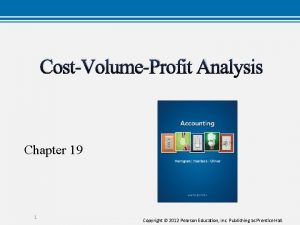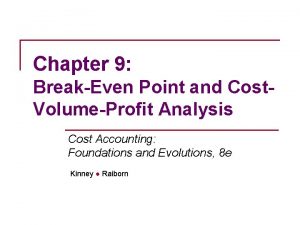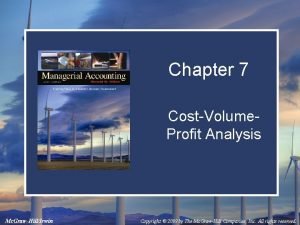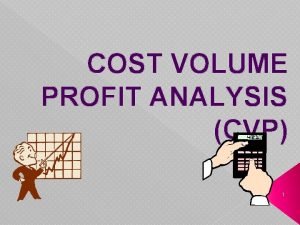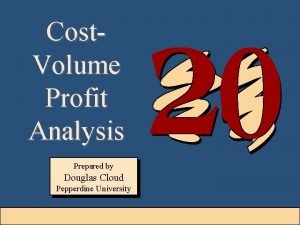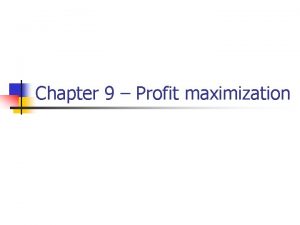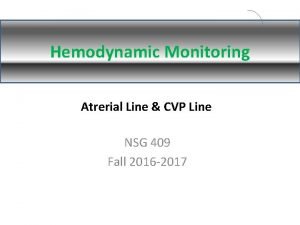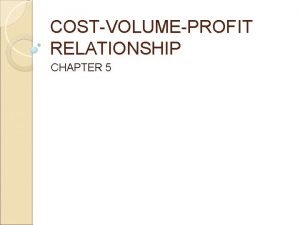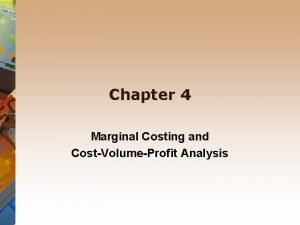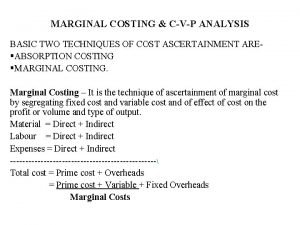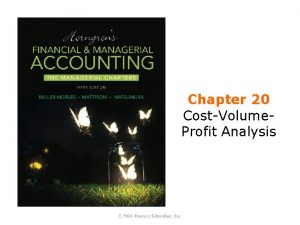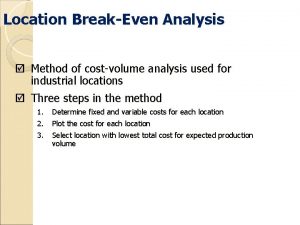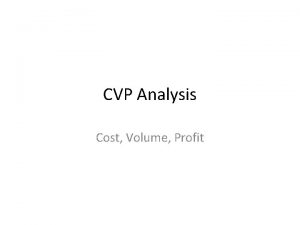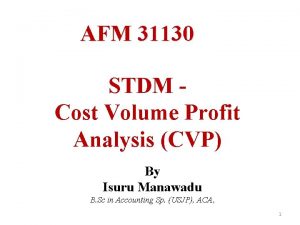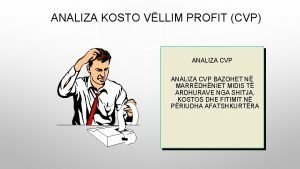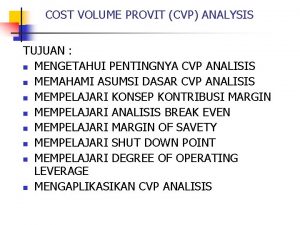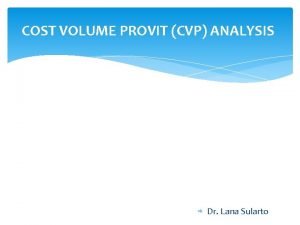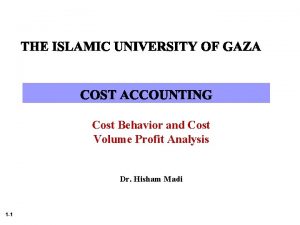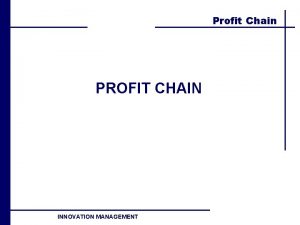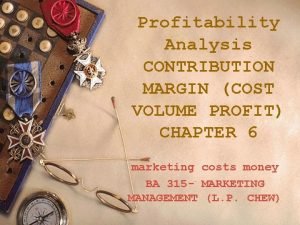Chapter 4 Cost Volume Profit Analysis CVP 2012

















- Slides: 17

Chapter 4 Cost Volume Profit Analysis (CVP) © 2012 Jones et al: Strategic Managerial Accounting: Hospitality, Tourism & Events Applications 6 thedition, Goodfellow Publishers

Objectives After studying this topic you should be able to: Ø Understand the concept and terminology of CVP; Ø Have a working knowledge of CVP calculations; Ø Appreciate the usefulness of CVP to managers as a decision making tool; and Ø Explore the use of ‘What if? ’ case scenarios with the aid of computer spread sheets. © 2012 Jones et al: Strategic Managerial Accounting: Hospitality, Tourism & Events Applications 6 thedition, Goodfellow Publishers

CVP terminology and concept (part 1) Ø Profit = Total Sales Revenue – Total costs Ø Contribution margin = Sales Revenue – Variable costs Ø Selling price – variable costs per unit = contribution per unit Ø Breakeven point (BEP) in units = Fixed Costs/contribution per unit Ø BEP for required profit = Fixed Costs + Required Profit Contribution per unit © 2012 Jones et al: Strategic Managerial Accounting: Hospitality, Tourism & Events Applications 6 thedition, Goodfellow Publishers

CVP terminology and concept (part 2) Ø C/S ratio = Contribution margin * 100 Sales Revenue Ø BEP in £ sales revenue = Fixed costs C/S ratio Ø Margin of Safety, in units = Estimated sales – breakeven sales Ø Margin of Safety % = Estimated sales – breakeven sales *100 Estimated sales © 2012 Jones et al: Strategic Managerial Accounting: Hospitality, Tourism & Events Applications 6 thedition, Goodfellow Publishers

Example Contribution Margin profit statement for Oriental Delight Restaurant Relevant range (meals) Sales Revenue 15, 000 Unit 30, 000 Unit £ 150, 000 £ 10 £ 300, 000 £ 10 Less: Variable costs £ 60, 000 £ 4 £ 120, 000 £ 4 Contribution Margin £ 90, 000 £ 6 £ 180, 000 £ 6 Less: Fixed costs £ 120, 000 Net profit (loss) -£ 30, 000 £ 60, 000 © 2012 Jones et al: Strategic Managerial Accounting: Hospitality, Tourism & Events Applications 6 thedition, Goodfellow Publishers

Solution (part 1) Selling price – variable costs per unit = contribution per unit £ 10 - £ 4 = £ 6 contribution per unit Breakeven point (BEP) in units = Fixed Costs/contribution per unit £ 120, 000/£ 6 = 20, 000 units To make a £ 15000 profit: £ 120, 000 + £ 15, 000 = 22, 500 units £ 6 C/S ratio = Contribution margin * 100 Sales Revenue £ 90, 000 * 100 = 60% £ 150, 000 © 2012 Jones et al: Strategic Managerial Accounting: Hospitality, Tourism & Events Applications 6 thedition, Goodfellow Publishers

Solution (part 2) Ø Oriental Delight BEP = £ 120, 000 = £ 200, 000 0. 60 (60%) Ø Margin of Safety, in units = Estimated sales – breakeven sales Ø Where estimated sales are 25000 units 25, 000 – 20, 000 = 5, 000 units Ø Margin of Safety % 25, 000 – 20, 000 *100 = 20% 25, 000 © 2012 Jones et al: Strategic Managerial Accounting: Hospitality, Tourism & Events Applications 6 thedition, Goodfellow Publishers

Graphical representations of CVP/BEP © 2012 Jones et al: Strategic Managerial Accounting: Hospitality, Tourism & Events Applications 6 thedition, Goodfellow Publishers

Margin of Safety on Graph © 2012 Jones et al: Strategic Managerial Accounting: Hospitality, Tourism & Events Applications 6 thedition, Goodfellow Publishers

Contribution Chart © 2012 Jones et al: Strategic Managerial Accounting: Hospitality, Tourism & Events Applications 6 thedition, Goodfellow Publishers

Profit/Volume Chart © 2012 Jones et al: Strategic Managerial Accounting: Hospitality, Tourism & Events Applications 6 thedition, Goodfellow Publishers

Underlying assumption in CVP analysis Ø Revenue and cost behaviour are linear i. e. are straight lines on the chart; Ø All variables, other than those under consideration remain constant, such as Ø Ø Ø Ø Selling price per unit will not change Variable costs vary in direct proportion to sales Fixed costs remain constant Cost prices remain constant e. g. food costs and staff wage rates Productivity remains unchanged Methods of production and service remain unchanged It covers a single product, or if multiple products (menu items) the sales mix remains unchanged; Ø All costs can be segregated into their fixed and variable components; Ø Revenue and costs are related to a single independent variable, which is level of activity (units sold); and Ø Volume of activity is the only relevant variable that determines cost behaviour. © 2012 Jones et al: Strategic Managerial Accounting: Hospitality, Tourism & Events Applications 6 thedition, Goodfellow Publishers

Computerised ‘What if? ’ analysis Benefits include: Ø Allows rapid computation Ø Gives instant feedback Ø Provides data flexibility Ø Provides alternative document forms Ø Formula can be viewed © 2012 Jones et al: Strategic Managerial Accounting: Hospitality, Tourism & Events Applications 6 thedition, Goodfellow Publishers

Spreadsheet design guidelines 1. 2. 3. 4. Prepare initial design on paper Separate input and output areas Enter a decision variable only once Never include a decision variable in a formula 5. Include a summary output screen 6. Incorporate instructions for users 7. Test the spreadsheet © 2012 Jones et al: Strategic Managerial Accounting: Hospitality, Tourism & Events Applications 6 thedition, Goodfellow Publishers

Spreadsheet example © 2012 Jones et al: Strategic Managerial Accounting: Hospitality, Tourism & Events Applications 6 thedition, Goodfellow Publishers

Spreadsheet example © 2012 Jones et al: Strategic Managerial Accounting: Hospitality, Tourism & Events Applications 6 thedition, Goodfellow Publishers

Summary Ø Relevant costs are those that are relevant to a specific decision being made. Ø An opportunity cost is concerned with the ‘missed opportunity’ when deciding between mutually exclusive options. Ø There are various types of short term decisions – each may have a slightly different focus or role within the organisation. Ø Short term decisions can have long term implications for an organisation. Ø Scarce resource can lead managers to focus on how to use them to maximise the return for the organisation. © 2012 Jones et al: Strategic Managerial Accounting: Hospitality, Tourism & Events Applications 6 thedition, Goodfellow Publishers
 When graphing cost-volume-profit data on a cvp chart:
When graphing cost-volume-profit data on a cvp chart: Cost behavior patterns
Cost behavior patterns Break-even point in units formula
Break-even point in units formula Cvp analysis assumptions
Cvp analysis assumptions Cost volume profit analysis graph
Cost volume profit analysis graph Bep in rm
Bep in rm Cost volume profit
Cost volume profit Normal profit vs economic profit
Normal profit vs economic profit Economic profit vs accounting profit
Economic profit vs accounting profit Post acquisition profit is which profit
Post acquisition profit is which profit Arterial line zeroing leveling
Arterial line zeroing leveling Cm% formula
Cm% formula Profit volume chart example
Profit volume chart example Chapter 18:5 determining net income
Chapter 18:5 determining net income Benefits of cvp analysis
Benefits of cvp analysis Cvp sensitivity analysis
Cvp sensitivity analysis Locational break even analysis example
Locational break even analysis example Locational cost volume analysis
Locational cost volume analysis
